Recently, CNN featured a photograph of a blackbird riding the back of a bald eagle, an image the correspondent called “almost too cute to be real.” The story fortunately went on to note that this was not a joyride, but the blackbird driving away an intruder.
While the photo is extraordinary, the behavior is not. I suspect most birders and backyard nature enthusiasts have seen numerous examples of a small bird – or flock of small birds – attacking a much larger and more imposing hawk, owl, or heron.
You may wonder what exactly would prompt a chickadee to take on red-tailed hawk. And, perhaps: how do the little birds survive such antics? Why doesn’t the hawk just grab an easy meal?
Here’s a primer on the avian dramas playing out in your neighborhood.
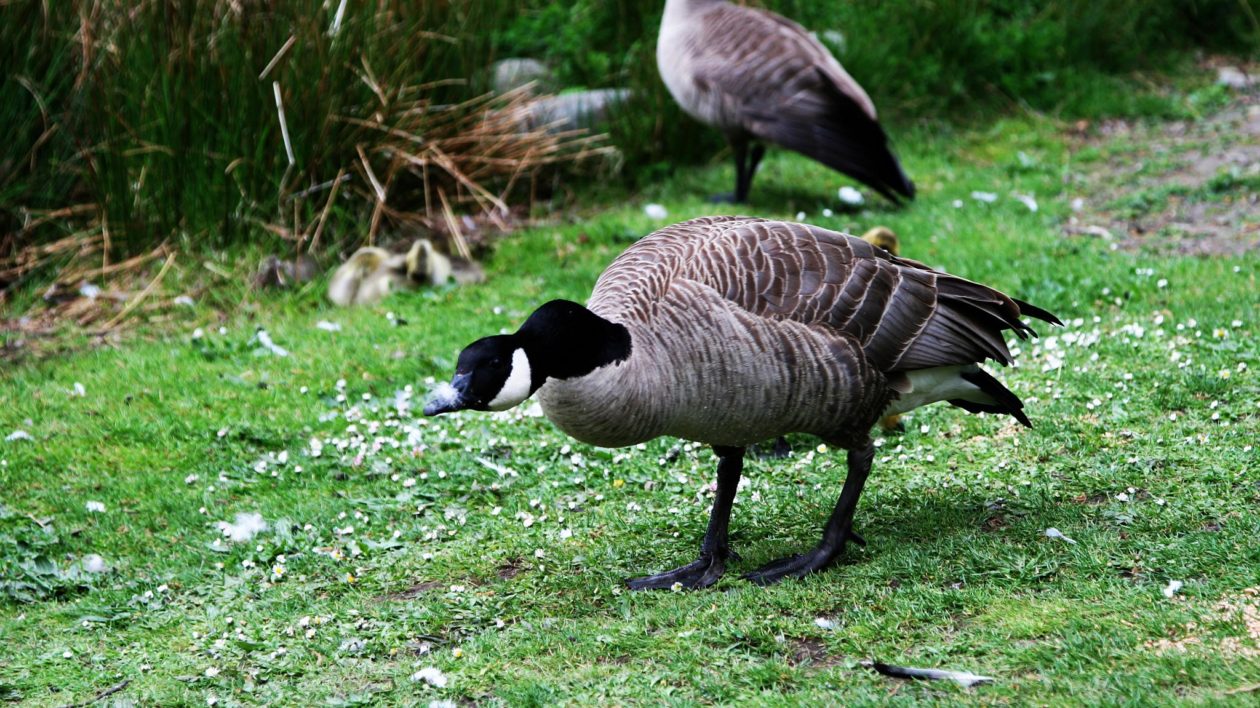
Defend The Territory
Many bird species are territorial during certain times of the year, and even small birds will fiercely defend their space. The reasons for territoriality vary. Some male birds set up territories to attract mates, and will fiercely drive off any rivals.
Other birds will set up on an abundant food source and become aggressive against intruders. Mockingbirds, for instance, will guard a berry tree in the fall. As Mass Audubon notes, “If there are bird feeders within a mockingbird’s feeding territory, other birds will be driven off, even though the mockingbird has no interest in the food offered at the feeder.”
But most birds are territorial to protect their nests. Birds will aggressively dive bomb any potential predator, large or small. This includes nest raiders like blue jays and avian predators like hawks, as well as cats, dogs and humans.
Even a seemingly innocuous robin can look quite fierce as it squawks and dive bombs your head. One set up a nest just off our back porch this summer, and its attacks were sufficient to deter my young son’s curiosity about the nestlings.
On a spring foray at dusk to try to catch a grass carp in an urban pond (don’t ask), I came a bit too close to a well-hidden Canada goose nest. The female came roaring out of the brush, hissing and flapping. On the terror scale, it may as well have been a grizzly bear.
In Australia, the “swooping season” of Australian magpies is almost a rite of passage, with bicyclists and walkers often subject to dramatic ambushes by these angriest of birds. And while this may be annoying or even scary for a human, it’s no doubt an effective deterrent. It would take a formidable predator to risk the pecking and battering of an enraged mama goose or magpie.
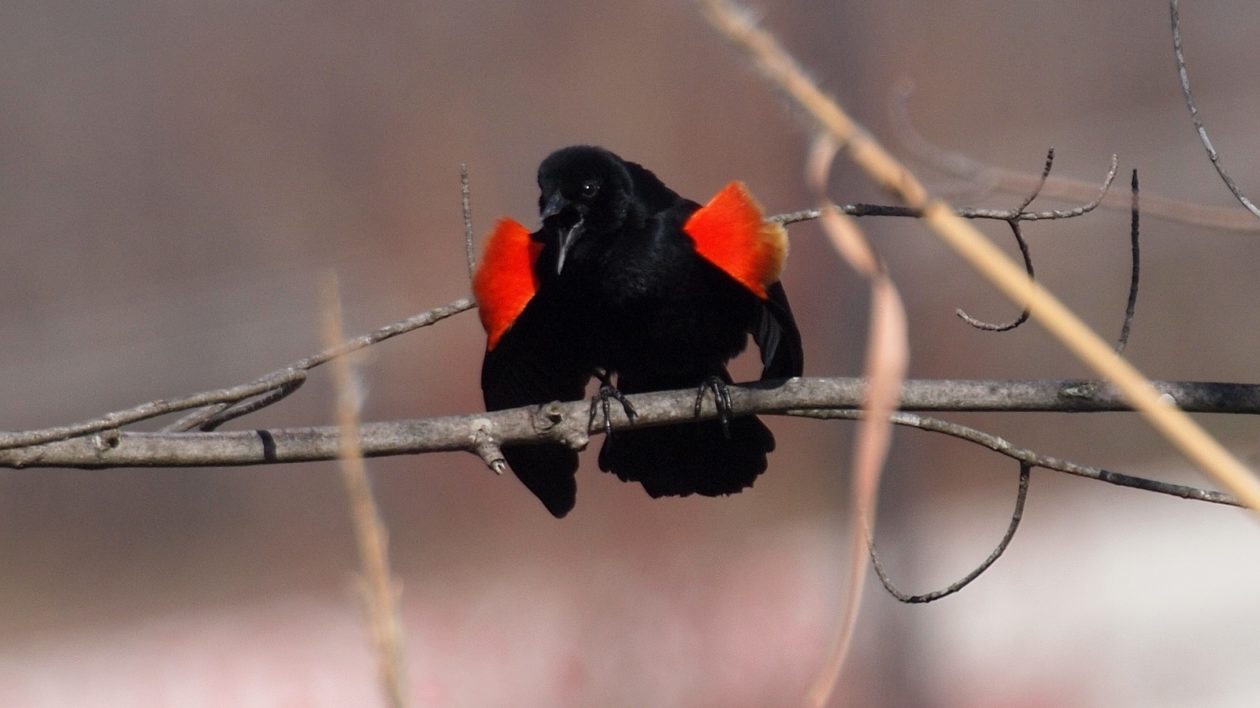
Red-Winged Warning
The red-winged blackbird – the bird photographed “riding” an eagle – exhibits particularly fascinating territorial behavior. Males set up territories where they call and display their red wings. As the Cornell Lab of Ornithology notes, as males mature, their black feathers get glossier and the red wings get brighter. The birds also do a flight display over their territory, flying at slow speed for a more dramatic display. According to the Lab’s publication All About Birds, “Older males secure the highest quality territories and the fittest mates. In experiments, males with blackened epaulets often lose their territories.”
Despite their territorial natures, red-winged blackbirds feed in large flocks in fields. To avoid unpleasant fights at dinner, male blackbirds tuck in their wings and don’t display at these times.
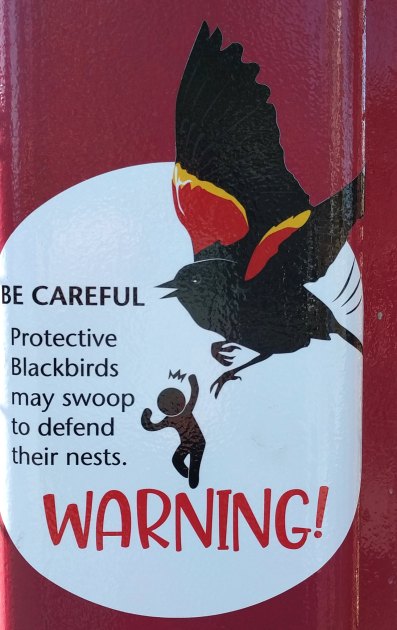
Back at its display ground, a red-winged blackbird will fend off rivals of its own species at its territory, but like many birds, will also drive away just about anything that gets near. Including bald eagles. And humans. Similar to other birds, though, red-winged blackbirds adapt their defensive strategies to the situation.
I frequently run along a greenbelt trail near my home in Boise, going by several blackbird display areas. I’ve never been attacked. The birds see joggers, walkers and bikers all day long. If they dive bombed every human, that’s all they’d do all day (and they’d probably lose their territories to less aggressive blackbirds).
However, I once did a 9-mile summer run along a very rural Iowa road. Judging by the honks and looks of passing cars, jogging was a far less common pastime there. And red-winged blackbirds dive bombed me along much of my route, and with relentless fury. I was large and threatening, and as such needed to be driven out of the territory.
Mob Mentality
Of course, it makes sense that birds would attempt to deter predators close to nests. But you may notice that a small bird (or flock of small birds) often chase and harass large hawks high in the sky, obviously far from any nests. Why?
Ornithologists say that there is a lot going on when birds mob a hawk, owl, heron or other large bird. The very presence of a bird of prey presents an existential threat to the avian neighborhood. As long as that bird’s around, nestlings are not safe. A red-tailed hawk could swoop out of the sky and snatch a baby bird before the parent even knows it’s gone.
The best defense, to invert the old sports cliché, is a good offense. And for small birds, going on the offensive means letting all other birds know that there’s danger overhead. Once the small birds know, they won’t be safe until they drive the danger away.
A mob of small birds makes it difficult for a hawk to hunt. And this is more than just an alarm: The bird sounds are also a call to arms (or…wings?) to all other small birds, regardless of species. The Cornell Lab explains: “The mobbing birds tend to use similar-sounding call notes, regardless of their species, and this may act to recruit other individuals to form a mobbing flock.”
Cornell also notes that this call is one familiar to birders, the “pishing” sound that draws in a variety of species. (It’s also why birders should not over-use this technique, as it can draw birds away from their nests).
Owls also draw bird mobs. At night, nesting birds are relatively defenseless. During the day, they can attempt to mob the owl until it moves away. Crows have a particularly violent reaction to owls, and as the cawing gets louder, more crows get drawn into the fray. I have seen more than 100 mob a single great-horned owl.
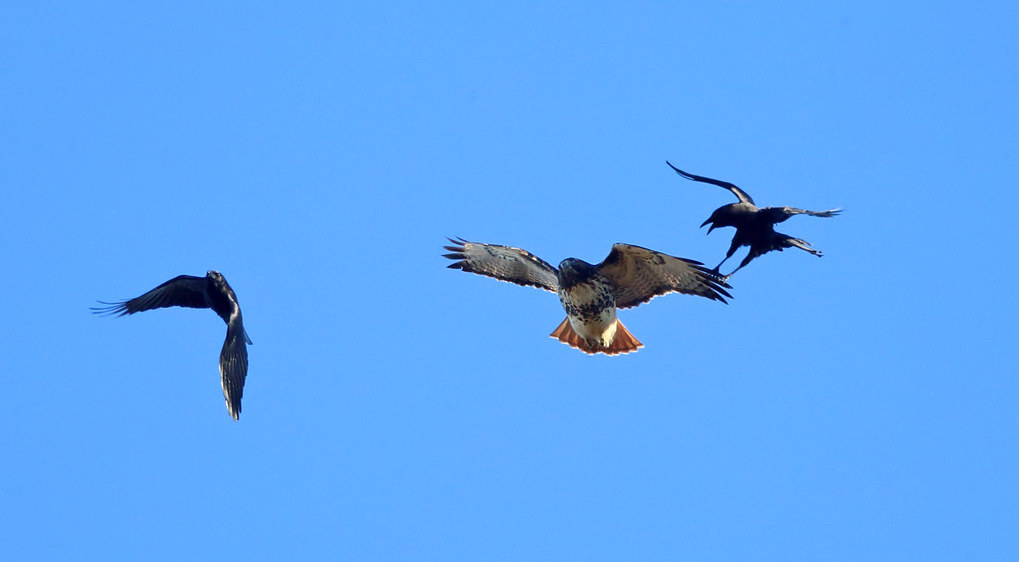
Why Don’t the Hawks Just Kill the Smaller Birds?
Let’s face it, a red-tailed hawk versus an American robin is hardly a fair fight. Even a mob of small birds would seem no match for a raptor with sharp talons. And yet small birds routinely chase and even make physical contact with their avian predators.
People witnessing these small bird attacks often ask: “Why doesn’t the hawk just kill the little birds?”
From the ground, it looks like it would be easy.
It isn’t. First, most predators rely on stealth attacks to catch prey. A raptor swoops from above and catches unaware prey. Alert prey is much, much more difficult to catch. This is true whether it is a wildebeest on the Serengeti, or a blue jay in your backyard. A prey species aware of its predator can use a full range of tactics to get away.
Add to this the fact that small birds are just more maneuverable than a large hawk or owl. If you look closely, you will see the small birds darting around, quickly shifting position. It takes a lot of energy for a soaring hawk to catch up to such a bird. This is even more true if the bird is roosting.
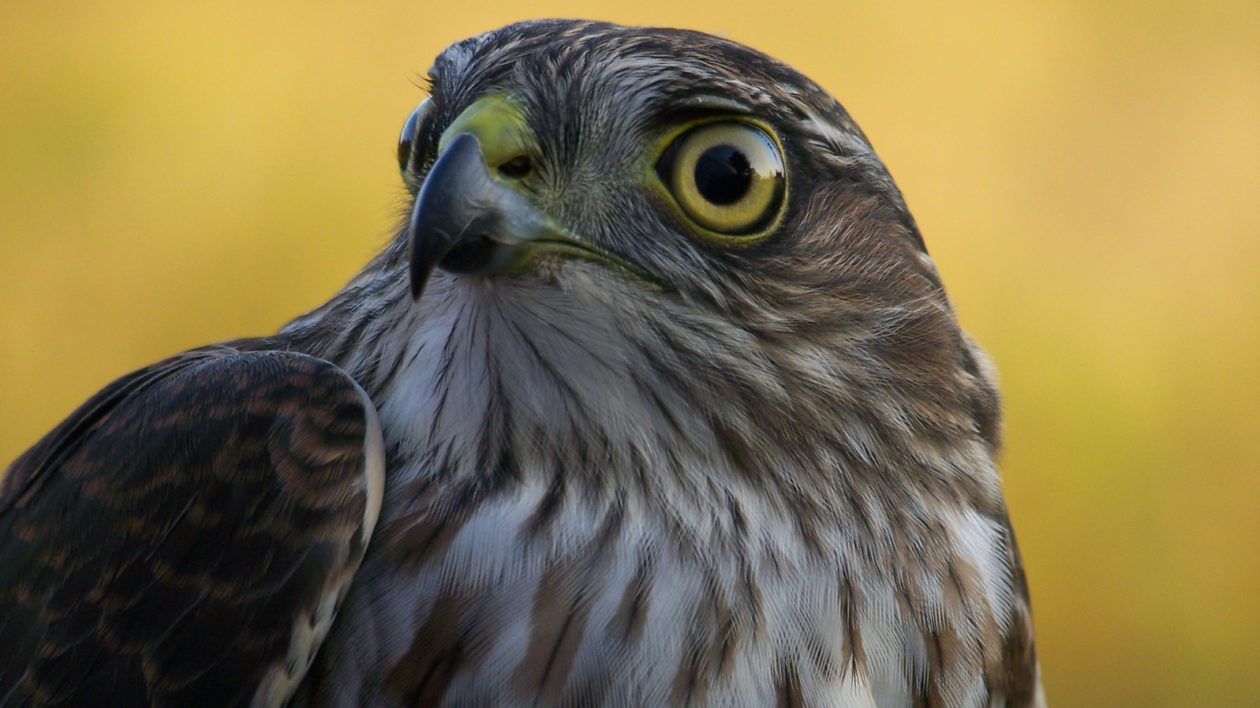
If you keep track of your observations, you’ll notice that the songbirds are nearly always mobbing larger predators, birds like red-tailed hawks and ospreys (even though ospreys usually prey on fish). A red-tailed hawk is a threat to nestlings but it’s unlikely to pluck a bird out of the sky.
Mobbing an aerial acrobat like a Cooper’s hawk – a raptor that can quickly negotiate suburban shrubs and trees – is a much riskier gamble. When a Cooper’s hawk is hunting in my neighborhood, the birds still raise the alarm cry quite loudly – but they’ll stay hidden while they do so.
Occasionally, you will see a red-tailed hawk grab a songbird. And great-horned owls will catch the occasional crow. When this happens, the songbird mob goes absolutely bonkers. It’s akin to a referee making a bad call against the home team. The ruckus draws even more birds to the mob.
In short, once a hawk or owl is mobbed by birds, the area is no longer a happy hunting ground. The predator will spend more energy getting prey than it is worth. And while it may not seem like a fair fight, the odds in this instance are stacked in the little bird’s favor.
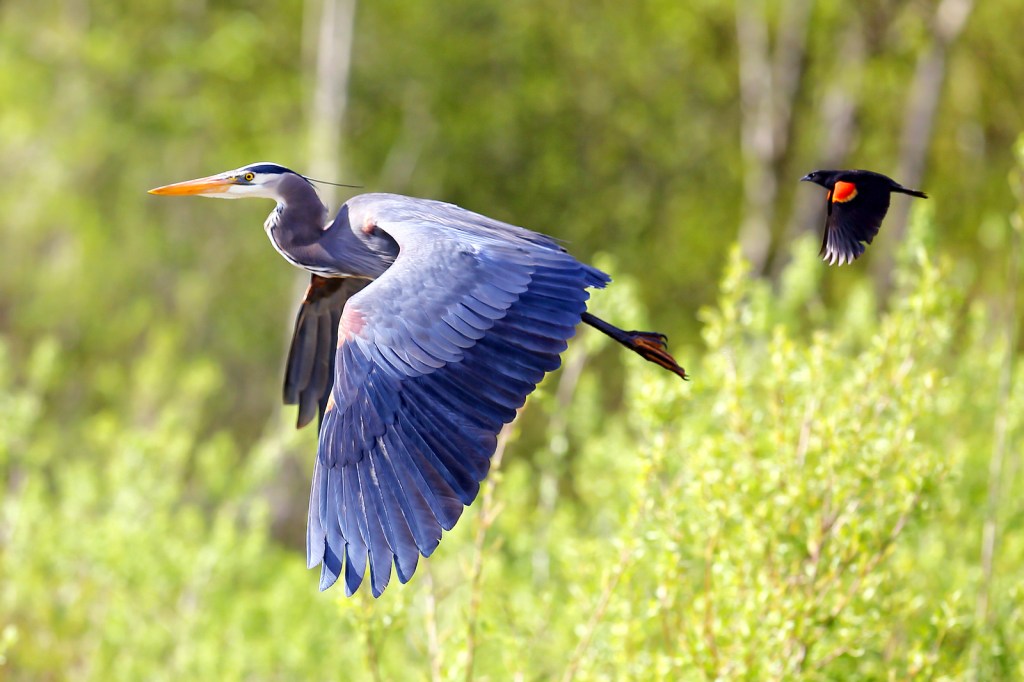



Great article. I’ve seen many examples of this behavior by Mockingbirds and Cactus Wrens in my own back yard over time. Always fun and fascinating to watch and now I have a deeper appreciation of what is really going on in my little birdy communities. Thanks so much!
Sooo interesting – thanks!
In our backyard in northeast TN, we recently observed a family of four Cooper’s Hawks frustrated by a single squirrel. When the hawks landed in any of our nearby trees, the squirrel would “get after them”, coming very close and seemingly eye-to-eye with them — but probably a little more than a half-bird length from the hawk. Eventually the hawks departed and the squirrel returned to his/her normal activities. I suspect that some of the factors that affected this encounter may be that adult squirrels are too strong and heavy to meet the hawks‘ normal prey-profile. The squirrel may have had a nearby, open nest. The hawks are probably not well adapted for catching prey with their beaks. The squirrel probably has faster reflexes than the hawk and is able to move around in the tree more quickly than the hawks. I’d be happy to receive comments from others on my observation and assumptions.
It is a fairly common scene where I live in California, a couple of crows relentlessly chasing some hawk three times their size across the sky while cawing loudly enough to be heard a quarter of a mile away. It can seem almost comical but, being a WWII history buff, for me these scenes evoke images of German fighters swarming Allied four engine bombers that make me realize this is not fun and games for either side!
I have often wondered about this behavior as i see it all the time around our home. Very informative, I’ll check these posts going forward. Thank you for sending.
We see more and more robins here in Manchester,NH. They come very close to us now. They never did this in the past. They have good luck pulling up worms, etc in this urban green area.
Great essay on the little birds mobbing the big guys. Very interesting. Here at my home backyard in the Skagit Valley of Western Washington State I’ve had a Cooper’s Hawk hanging around off and on for several days. I came home yesterday and glanced out the window to see him perched on top of my multiple hook bird feeder. Gosh he looked huge and so out of place. Obviously all my lovely songbirds were in hiding and very quiet. What the hawk did next though was quite interesting, he dropped off the feeder to the ground where I have a large bird bath, he was thirsty and proceeded to drink for a couple of minutes then flew off. It has been so very dry and warm here so I can’t blame him one bit for taking advantage of fresh clean water.
My husband uses a walker. While walking in a campground in San Diego, a Canadian goose came tearing out of the shade at least 50 yards away and kept attacking the walker. Although the walker gave us protection, we didn’t dare try to turn around. It was quite a standoff. Eventually the goose retreated far enough for us to also retreat!
The correct name is CANADA GOOSE. Not all of them are Canadian. (smile)
SO INTERESTING, MATT. THANK YOU.
I enjoyed your article. You might need to rethink your conclusions about running in the Iowa countryside, however. It’s not so much that runners are a novelty (they’re not) but that they are curious about the stranger in their midst, and friendly enough to honk and wave.
A Former Iowan
As a longtime avid birder, I’ve seen gobs of interactions between birds. I recently set up a trail cam on my feeders and have video of several visitors. One that pertains to the article is between a turkey and six crows. The turkey goes out of her way to chase the crows every time she comes upon them at the feeders.
Thank you so much for the very interesting article on little birds attacking big birds.
This was so informative and well written. I really enjoyed the article along with the beautiful pictures. It answered things I had thought about from time to time.
interesting..some things i did not know
This is an excellent and informative article. Kudos.